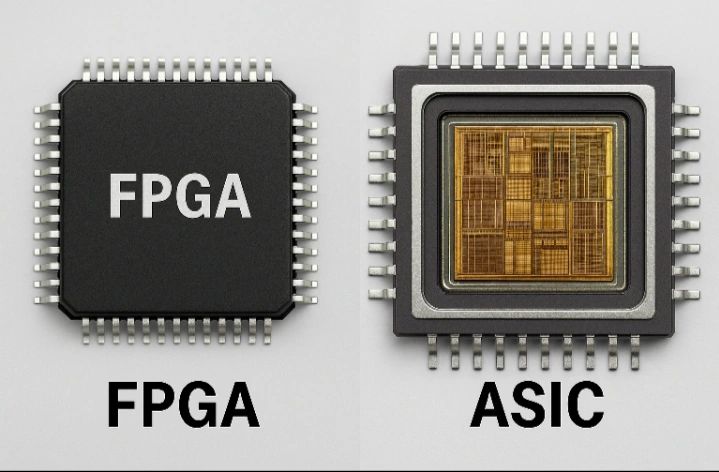Time: 2025-05-14 11:43:22View:
ASICs (Application-Specific Integrated Circuits) and FPGAs (Field-Programmable Gate Arrays) are both used for digital hardware design, but they serve different purposes and have distinct trade-offs. Here’s a detailed comparison and guidance on selecting the right solution.

| Criteria | ASIC | FPGA |
|---|---|---|
| Customization | Fully custom-designed for a specific task | Reconfigurable (can be reprogrammed) |
| Performance | Higher speed, lower latency (optimized for one task) | Slower due to programmable logic overhead |
| Power Efficiency | Much lower power consumption (optimized silicon) | Higher power consumption (static + dynamic power) |
| Cost | High upfront cost (NRE: 10M+) | Low initial cost (10K per board) |
| Time-to-Market | Long (months to years for design & fabrication) | Fast (minutes to hours for reprogramming) |
| Flexibility | Fixed functionality (cannot be changed after fabrication) | Reconfigurable (can update logic anytime) |
| Volume | Cost-effective at high volumes (>1M units) | Better for low-to-medium volumes (prototyping, niche applications) |
| Toolchain | Complex (Cadence, Synopsys tools, tape-out process) | Easier (Xilinx Vivado, Intel Quartus, open-source tools) |
✅ High-volume production (e.g., smartphones, IoT chips, GPUs).
✅ Ultra-low power (battery-operated devices like wearables).
✅ Maximum performance (high-speed networking, AI accelerators).
✅ Cost-sensitive at scale (per-unit cost drops massively at scale).
❌ High NRE (Non-Recurring Engineering) costs (mask sets, verification, testing).
❌ Long development time (6–24 months).
❌ No flexibility after fabrication (bugs require a respin).
✅ Prototyping & validation (ASIC emulation, pre-silicon testing).
✅ Low-to-medium volume (military, aerospace, medical devices).
✅ Reconfigurability needed (firmware updates, adaptive hardware).
✅ Fast time-to-market (no fabrication delay).
❌ Higher power consumption (not ideal for battery-powered devices).
❌ Slower than ASICs (due to programmable routing overhead).
❌ Cost-prohibitive at scale (>10K units).
Structured ASICs: Semi-custom (pre-built layers + customizable logic).
→ Lower NRE than full ASICs, but less flexible than FPGAs.
eFPGAs (Embedded FPGAs): FPGA fabric integrated into an ASIC/SOC.
→ Useful for post-silicon updates (e.g., Google TPUs).
Your design is finalized (no future changes needed).
You need mass production (>1M units).
Power/performance is critical (e.g., mobile chips).
You’re in R&D or prototyping phase.
Your design may need updates (e.g., aerospace, defense).
Low volumes (avoiding high NRE costs).
Start with FPGA for prototyping.
Migrate to ASIC once the design is stable and volumes justify cost.
ASIC Users: Apple (A-series chips), NVIDIA (GPUs), Qualcomm (Snapdragon).
FPGA Users: SpaceX (satellite comms), CERN (particle detectors), 5G base stations.
FPGAs = Flexibility, fast iteration, low-volume.
ASICs = Performance, power efficiency, high-volume.
For startups and R&D, FPGAs are the best starting point. For mass-market products, ASICs save costs long-term.